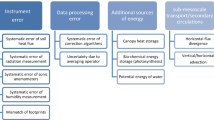Abstract
The role of clouds in photodissociation is examined by both modeling and observations. It is emphasized that the photodissociation rate is proportional to the actinic flux rather than to the irradiance. (The actinic flux concerns the energy that is incident on a molecule, irrespective of the direction of incidence. The irradiance concerns the energy that is incident on a plane.) A 3-layer model is used to calculate the actinic flux above and below a cloud, relative to the incident flux, in terms of cloud albedo, zenith angle and the albedo of the underlying and overlying atmosphere. Cloud albedo is mainly determined by cloud optical thickness. An expression for the in-cloud actinic flux is given as a function of in-cloud optical thickness. The 3-layer model seems to be an useful model for estimation of photodissociation rates in dispersion models. Further, a multi-layer delta-Eddington model is used to calculate irradiances, actinic fluxes and photodissociation rates of nitrogen dioxide J(NO2) as a function of height in inhomogeneous atmospheres. For the considered wavelength interval [290–420 nm], Rayleigh scattering, ozone absorption and Mie scattering and absorption by cloud drops and aerosols should be taken into account. It is stressed that both models are one-dimensional and as such are unable to deal with partial cloudiness. It is shown that if no clouds are present, the actinic flux depends primarily on the solar zenith angle. The actinic flux usually increases with height. For cloudy atmospheres, another important parameter with respect to the actinic flux is added: cloud optical thickness, which determines cloud albedo. It can be shown that in-cloud characteristics and cloud height are less important in describing the effect of a cloud on the actinic flux (outside the cloud). The in-cloud values of the actinic flux can exceed the values outside the cloud. Finally, using the photostationary state relationship, good agreement is found between model results and aircraft measurements.
Similar content being viewed by others
References
Deirmendjian, D., 1969.Electromagnetic scattering on spherical polydispersions, Elsevier Publ. Co., New York, USA.
Demerjian, K.L., K.L. Schere, and J.T. Peterson, 1980.Theoretical estimates of actinic (spherically integrated) flux and photolytic rate constants of atmospheric species in the lower troposphere. Adv. Environ. Sci. Technolo.,10, 369–459.
Edlen, B., 1953.the dispersion of standard air. J. Opt. Soc. Am.,43, 339–344.
Finlayson-Pitts, B.J., and J.N. Pitts Jr., 1986.Atmospheric Chemistry. John Wiley and Sons, New York, USA.
Hale, G.M. and M.R. Querry, 1973.Optical constants of water in 200 nm to 200 μm wavelength region. Appl. Opt.,12, 555–563.
Hansen, J.E. and L.D. Travis, 1974.Light scattering in planetary atmospheres. Space Sci. Rev.,16, 527–610.
Joseph, J.H., Wiscombe, W.J. and J.A. Weinman, 1976.The delta- Eddington approximation for radiative flux trasnfer. J. Atmos. Sci.33, 2452–2459.
King, M.D. and Harshvardhan, 1986.Comparative accuracy of selected multiple scattering approximations. J. Atmos. Sci.,43, 784–801.
Lacis, A.A., and J.E. Hansen, 1974.A parameterization for the absorption of solar radiation in the Earth's atmosphere. J. Atmos. Sci.,31, 118–133.
Madronich, S., 1987.Photodissociation in the Atmosphere: 1. Actinic flux and the effects of ground reflections and clouds. J. Geophys. Res. D.,92, 9740–9752.
Press, W.H., Flannery, B.P., Teukolsky, S.A., and W.T. Vetterling, 1986.Numerical Recipes, Chap. 2, p. 40–41, Cambridge Univ. Press, Cambridge.
Shettle, E.P., and J.A. Weinman, 1970.The transfer of solar irradiance through inhomogeneous atmospheres evaluated by Eddington's approximation. J. Amos. Sci.,27, 1048–1055.
Slingo, A., and H.M. Schrecker, 1982.On the shortwave radiative properties of stratiform water clouds. Quart. J.R. Met. Soc.,108, 407–426.
Stephens, G.L., 1978.Radiative properties of extended water clouds, Part II. J. Atmos. Sci.,35, 2123–2132.
Thompson, A.M., 1984.The effect of clouds on photolytic rates and ozone formation in the unpolluted troposphere. J. Geoph. Res. D.89, 1341–1349.
Van Broekhuizen, H.J. and A. van Kuijk, 1990.The chemical composition of cloud and rain water, 1st measuring compaign, 15 September 1989. GEOSENS b.v. PO Box 12067, 3004 GB Rotterdam, The Netherlands (in Dutch).
van de Hulst, H.C., 1974.The spherical albedo of a planet covered with a homogeneous cloud layer. Astron. Astrophys.,35, 209–214.
van de Hulst, H.C., 1981.Light scattering by small particles Dover Publ., New York, USA.
Author information
Authors and Affiliations
Rights and permissions
About this article
Cite this article
Duynkerke, P.G., Van Weele, M. Actinic fluxes: The role of clouds in photodissociation. Boundary-Layer Meteorol 62, 417–432 (1993). https://doi.org/10.1007/BF00705570
Received:
Issue Date:
DOI: https://doi.org/10.1007/BF00705570




